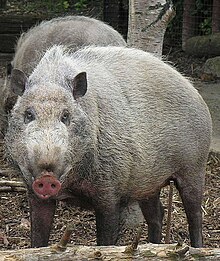Pig
| Pig Temporal range: to recent |
|
|---|---|
 |
|
| Bornean bearded pig at the London Zoo. | |
| Scientific classification | |
| Kingdom: | Animalia |
| Phylum: | Chordata |
| Class: | Mammalia |
| Order: | Artiodactyla |
| Family: | Suidae |
| Subfamily: | Suinae |
| Genus: |
Sus Linnaeus, 1758 |
| Species | |
|
|
A pig is any of the animals in the genus Sus, within the Suidae family of even-toed ungulates. Pigs include the domestic pig and its ancestor, the common Eurasian wild boar (Sus scrofa), along with other species; related creatures outside the genus include the peccary, the babirusa, and the warthog. Pigs, like all suids, are native to the Eurasian and African continents. Juvenile pigs are known as piglets. Pigs are highly social and intelligent animals.
With around 1 billion individuals alive at any time, the domesticated pig is one of the most numerous large mammals on the planet. Pigs are omnivores and can consume a wide range of food, similar to humans. Pigs can harbour a range of parasites and diseases that can be transmitted to humans. Because of the similarities between pigs and humans, pigs are used for human medical research.
The Online Etymology Dictionary provides anecdotal evidence as well as linguistic, saying that the term derives
probably from Old English *picg, found in compounds, ultimate origin unknown. Originally "young pig" (the word for adults was swine). Apparently related to Low German bigge, Dutch big ("but the phonology is difficult" -- OED). ... Another Old English word for "pig" was fearh, related to furh "furrow," from PIE *perk- "dig, furrow" (source also of Latin porc-us "pig," see pork). "This reflects a widespread IE tendency to name animals from typical attributes or activities" [Roger Lass]. Synonyms grunter, porker are from sailors' and fishermen's euphemistic avoidance of uttering the word pig at sea, a superstition perhaps based on the fate of the Gadarene swine, who drowned.
...
Wikipedia
